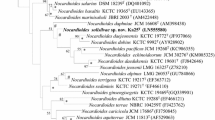Summary
-
1.
A nocardia-like bacterium, isolated from an o-toluanilide soil enrichment culture, is able to use the systemic fungicides o-toluanilide, o-iodobenzanilide, 2,5-dimethyl-furan-3-carboxanilide, carboxin (5,6-dihydro-2-methyl-1,4 oxathiin-3-carboxanilide) and oxycarboxin (5,6-dihydro-2-methyl-1,4-oxathiin-3-carboxanilide-4,4-dioxide) as sole sources of carbon and nitrogen.
-
2.
Growth is also observed in a mineral-salts medium with aniline, acetanilide, IPC (isopropyl-N-phenylcarbamate), phenol, paraffin and other carbon sources.
-
3.
The bacterium, preliminarily designated A 1, is characterized by growth tests and biochemical tests.
Similar content being viewed by others
Abbreviations
- OTA:
-
o-toluanilide
- FCA:
-
2,5-dimethyl-furan-3-carboxanilide
- carboxin:
-
5,6-dihydro-2-methyl-1,4-oxathiin-3-carboxanilide
- oxycarboxin:
-
5,6-dihydro-2-methyl-1,4-oxathiin-3-carboxanilide-4,4-dioxide
- IPC:
-
isopropyl-N-phenylcarbamate
References
Bartha, R., Pramer, D.: Metabolism of acylanilide herbicides. Advanc. appl. Microbiol. 13, 317–341 (1970).
Breed, R. S., Murray, E. G. D., Smith, N. R.: Bergey's Manual of determinative bacteriology, 7th ed. Baltimore: Williams and Wilkins 1957.
Chin, W. T., Stone, G. M., Smith, A. E.: Metabolism of carboxin (vitavax) by barley and wheat plants. J. Agr. Food Chem. 18, 709–712 (1970a).
Chin, W. T., Stone, G. M., Smith, A. E.: Degradation of carboxin (vitavax) in water and soil. J. Agr. Food Chem. 18, 731–732 (1970b).
Clark, G. C., Wright, S. I. L.: Detoxication of isopropyl-N-phenylcarbamate (IPC) and isopropyl-N-3-chlorophenylcarbamate (CIPC) in soil, and isolation of IPC-metabolizing bacteria. Soil Biol. Biochem. 2, 19–26 (1970a).
Clark, G. C., Wright, S. I. L.: Degradation of the herbizide isopropyl-N-phenylcarbamate by Arthrobacter and Achromobacter spp. from soil. Soil Biol. Biochem. 2, 217–226 (1970b).
Engelhardt, G., Wallnöfer, P. R., Plapp, R.: Degradation of Linuron and some other herbicides and fungicides by a Linuron-inducible enzyme obtained from Bacillus sphaericus. Appl. Microbiol. 22, 284–288 (1971).
Georgopoulos, S. G., Alexandri, E., Chrysayi, M.: Genetic evidence for the action of oxathiin and thiazole derivatives on the succinic dehydrogenase system of Ustilago maydis mitochondria. J. Bact. 110, 809–817 (1972).
Gordon, R. E.: Some strains in search of a genus—Corynebacterium, Mycobacterium, Nocardia or what? J. gen. Microbiol. 43, 329–343 (1966).
Gordon, R. E., Mihm, J. M.: A comparative study of some strains received as nocardiae. J. Bact. 73, 15–27 (1957).
Gordon, R. E., Mihm, J. M.: A comparison of four species of mycobacteria. J. gen. Microbiol. 21, 736–748 (1959).
Pommer, E. H.: The systemic activity of a new fungicide of the furane carbonic acid aniline group (BAS 3191 F). In: Pesticide chemistry, Vol. V, Herbicides, fungicides, formulation chemistry, ed. A. S. Tahori, pp. 397–404. New York: Gordon and Breach Science Publishers 1972.
Snel, M., von Schmeling, B., Edgington, L. V.: Fungitoxicity and structure-activity relationships of some oxathiin and thiazole derivatives. Phytopathology 60, 1164–1169 (1970).
Society of American Bacteriologists: In: H. J. Conn, Manual of microbiological methods. New York: Mc Graw-Hill 1957.
Ulrich, J. T., Mathre, D. E.: Mode of action of oxathiin systemic fungicides. V. Effect on electron transport system of Ustilago maydis and Saccharomyces cerevisiae. J. Bact. 110, 628–632 (1972).
Wallnöfer, P. R., Königer, M., Safe, S., Hutzinger, O.: Metabolism of the systemic fungicide 2,5-dimethyl-3-furancarboxylic acid anilide (BAS 3191 F) by Rhizopus japonicus and related fungi. J. Agr. Food Chem. 20, 20–22 (1972a).
Wallnöfer, P. R., Königer, M., Safe, S., Hutzinger, O.: The metabolism of the systemic fungicide carboxin (vitavax) by Rhizopus japonicus. Intern. J. Environ. Anal. Chem. 2, 37–43 (1972b).
Wallnöfer, P. R., Safe, S., Hutzinger, O.: Metabolism of the systemic fungicides 2-methylbenzanilide and 2-chlorobenzanilide by Rhizopus japonicus. Pest. Biochem. Phys. 1, 458–463 (1971).
White, G. A.: A potent effect of 1,4-oxathiin systemic fungicides on succinate oxidation by a particulate preparation from Ustilago maydis. Biochem. biophys. Res. Commun. 44, 1212–1219 (1971).
Author information
Authors and Affiliations
Rights and permissions
About this article
Cite this article
Bachofer, R., Oltmanns, O. & Lingens, F. Isolation and characterization of a Nocardia-like soil-bacterium, growing on carboxanilide fungicides. Archiv. Mikrobiol. 90, 141–149 (1973). https://doi.org/10.1007/BF00414516
Received:
Issue Date:
DOI: https://doi.org/10.1007/BF00414516




